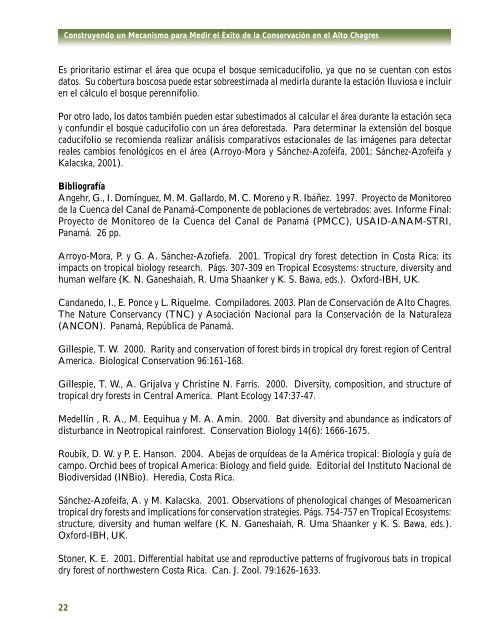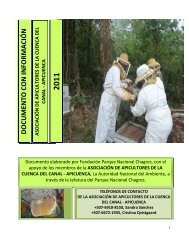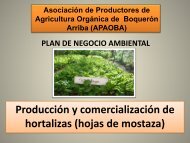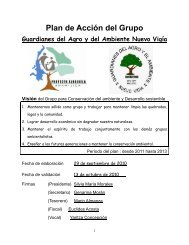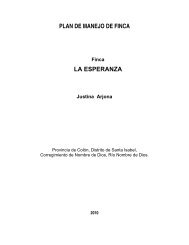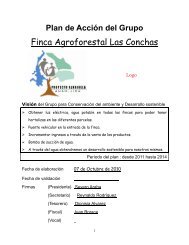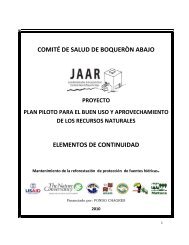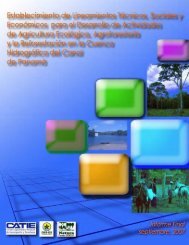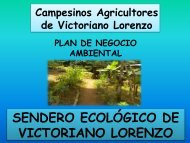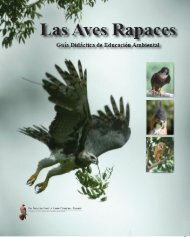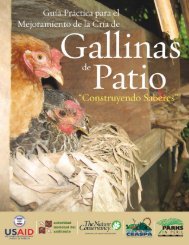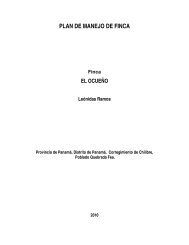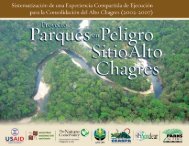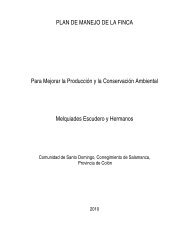Plan de Monitoreo del Alto Chagres - CICH
Plan de Monitoreo del Alto Chagres - CICH
Plan de Monitoreo del Alto Chagres - CICH
Create successful ePaper yourself
Turn your PDF publications into a flip-book with our unique Google optimized e-Paper software.
Construyendo un Mecanismo para Medir el Éxito <strong>de</strong> la Conservación en el <strong>Alto</strong> <strong>Chagres</strong>Es prioritario estimar el área que ocupa el bosque semicaducifolio, ya que no se cuentan con estosdatos. Su cobertura boscosa pue<strong>de</strong> estar sobreestimada al medirla durante la estación lluviosa e incluiren el cálculo el bosque perennifolio.Por otro lado, los datos también pue<strong>de</strong>n estar subestimados al calcular el área durante la estación secay confundir el bosque caducifolio con un área <strong>de</strong>forestada. Para <strong>de</strong>terminar la extensión <strong>de</strong>l bosquecaducifolio se recomienda realizar análisis comparativos estacionales <strong>de</strong> las imágenes para <strong>de</strong>tectarreales cambios fenológicos en el área (Arroyo-Mora y Sánchez-Azofeifa, 2001; Sánchez-Azofeifa yKalacska, 2001).BibliografíaAngehr, G., I. Domínguez, M. M. Gallardo, M. C. Moreno y R. Ibáñez. 1997. Proyecto <strong>de</strong> <strong>Monitoreo</strong><strong>de</strong> la Cuenca <strong>de</strong>l Canal <strong>de</strong> Panamá-Componente <strong>de</strong> poblaciones <strong>de</strong> vertebrados: aves. Informe Final:Proyecto <strong>de</strong> <strong>Monitoreo</strong> <strong>de</strong> la Cuenca <strong>de</strong>l Canal <strong>de</strong> Panamá (PMCC), USAID-ANAM-STRI,Panamá. 26 pp.Arroyo-Mora, P. y G. A. Sánchez-Azofiefa. 2001. Tropical dry forest <strong>de</strong>tection in Costa Rica: itsimpacts on tropical biology research. Págs. 307-309 en Tropical Ecosystems: structure, diversity andhuman welfare (K. N. Ganeshaiah, R. Uma Shaanker y K. S. Bawa, eds.). Oxford-IBH, UK.Candanedo, I., E. Ponce y L. Riquelme. Compiladores. 2003. <strong>Plan</strong> <strong>de</strong> Conservación <strong>de</strong> <strong>Alto</strong> <strong>Chagres</strong>.The Nature Conservancy (TNC) y Asociación Nacional para la Conservación <strong>de</strong> la Naturaleza(ANCON). Panamá, República <strong>de</strong> Panamá.Gillespie, T. W. 2000. Rarity and conservation of forest birds in tropical dry forest region of CentralAmerica. Biological Conservation 96:161-168.Gillespie, T. W., A. Grijalva y Christine N. Farris. 2000. Diversity, composition, and structure oftropical dry forests in Central America. <strong>Plan</strong>t Ecology 147:37-47.Me<strong>de</strong>llín , R. A., M. Eequihua y M. A. Amin. 2000. Bat diversity and abundance as indicators ofdisturbance in Neotropical rainforest. Conservation Biology 14(6): 1666-1675.Roubik, D. W. y P. E. Hanson. 2004. Abejas <strong>de</strong> orquí<strong>de</strong>as <strong>de</strong> la América tropical: Biología y guía <strong>de</strong>campo. Orchid bees of tropical America: Biology and field gui<strong>de</strong>. Editorial <strong>de</strong>l Instituto Nacional <strong>de</strong>Biodiversidad (INBio). Heredia, Costa Rica.Sánchez-Azofeifa, A. y M. Kalacska. 2001. Observations of phenological changes of Mesoamericantropical dry forests and implications for conservation strategies. Págs. 754-757 en Tropical Ecosystems:structure, diversity and human welfare (K. N. Ganeshaiah, R. Uma Shaanker y K. S. Bawa, eds.).Oxford-IBH, UK.Stoner, K. E. 2001. Differential habitat use and reproductive patterns of frugivorous bats in tropicaldry forest of northwestern Costa Rica. Can. J. Zool. 79:1626-1633.22


